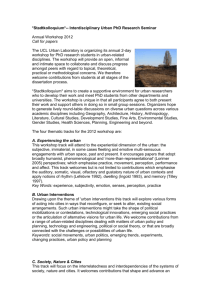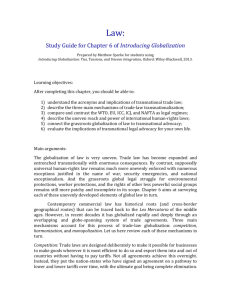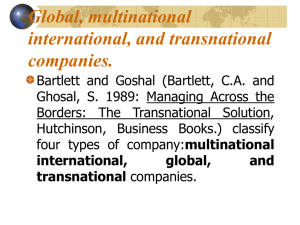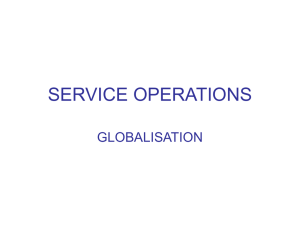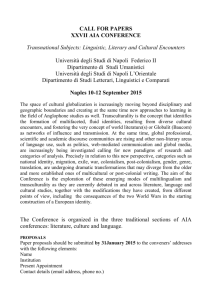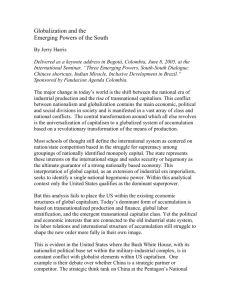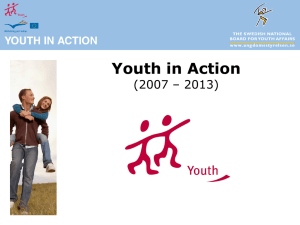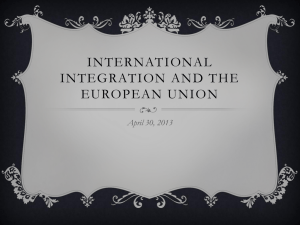Counterhegemonic Globalization: Transnational Social Movements
advertisement
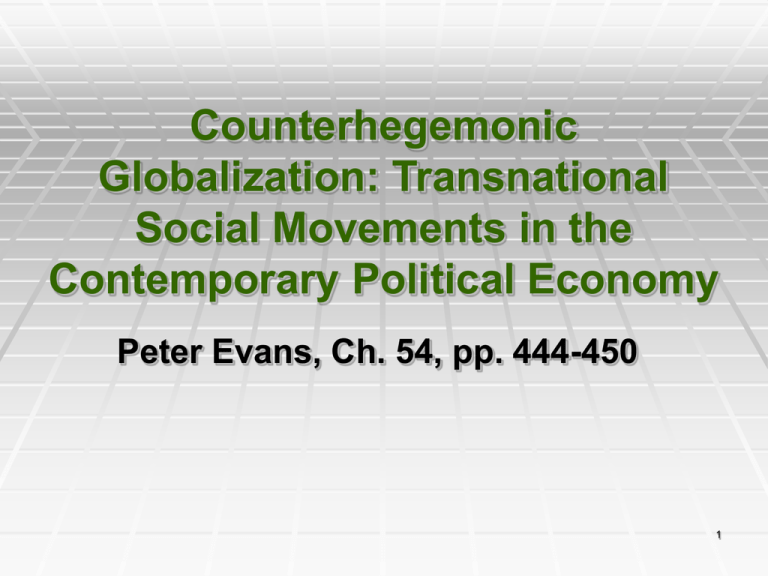
Counterhegemonic Globalization: Transnational Social Movements in the Contemporary Political Economy Peter Evans, Ch. 54, pp. 444-450 1 Defining terms When people invoke GL, they usually mean the prevailing system of transnational domination – or hegemony which is more accurately called "neoliberal globalization“ or "corporate globalization" 2 Implicit in current discourse is idea that this kind of globalization is "natural," inevitable, determined by market logic Such discourse has become hegemonic hegemony: domination, influence, or authority over another, especially one political group over a society or by nation over others when a discourse is hegemonic it conforms to the dominant ideology, which justifies the status quo 3 Counterhegemonic globalization counterhegemonic globalization challenges the prevailing system of transnational domination – and the ideologies that justify it 4 Activists involved in this project are collectively referred to as the "global justice movement" part of global civil society, but more critical wing the formally organized participants in the movement work through transnational NGOs the anti-globalization protests at the 1999 WTO meeting in Seattle and the ongoing World Social Forum are key events in the movement 5 World Economic Forum vs World Social Forum World Social Forum, which brings together transnational social activists, especially from the global south, was organized as a "counter-meeting" to the World Economic Forum, which is an annual gathering of leaders in business and politics held in Davos, Switzerland 6 New Organizational Foundations of Counterhegemonic Globalization (CHG) 3 broad families of transnational social movements: Labor movement Women's movement Environmental movement 7 Unique challenges of organizing transnationally? dilemma of using transitional networks to magnify the power of local movements without redefining local interests transcending the North-South divide leveraging existing structures of global power without becoming complicit in them 8 WSF: quintessential example of CHG World Social Forum: probably largest network of South-based organizations and activists began as a joint venture between ATTAC (Association for the Taxation of Financial Transactions for the Aid of Citizens) and the Brazilian Workers Party (PT) demonstrates how CHG has its roots in both everyday struggles for dignity and economic security in the workplace and classic agendas of social protection CHG is NOT postmodern, but looks to rescue traditional social democratic agendas of social protection 9 Labor as a Global Social Movement Neoliberal GL has effectively reconstructed employment as something more like a "spot market" in which labor is brought and sold like any other commodity Across the world, jobs are being informalized, outsourced, and generally divorced from a social contract between employer and employee 10 The attack on the labor contract, since it's global, creates a powerful basis for global labor solidarity Ex #1: mutual support between metalworkers in Brazil and Germany the alliance exploits transnational corporate organizational structures for counterhegemonic purposes Ex #2:1997 UPS strike North-North example of how transitional social alliances can be built around idea of a social contract Formal employment relationship with union representation is rare, so the success of labor as a global social movement depends on being able to complement "social contract" and “basic rights" with other strategies that have the potential for generating alliances 11 Building a feminist movement without borders Disadvantages of allocating resources purely on basis of market logic will fall on women “Care deficit": women spend most working hrs on unpaid care work…."market gives almost no rewards for care" Structural adjustment and other neoliberal programs have built-in systematic gender bias Feminist activists have advantage over labor in that they don't have to transcend the "zero-sum" logic equivalent to that of the "geography of jobs" (in the case of the labor movement) 12 How to bridge political and cultural aspects of the North-South divide and how to avoid the potential dangers of "difference-erasing universalist agendas“? Like labor movement, feminism is rooted in universalist discourse of human rights, but transnational feminism has long wrestled with contradictions of building politics around the universalistic language of rights a one-size fits all approach will not work 13 Global and local environmentalism Advantage: The "environment" is inherently a transnational issue, which gives the transnational environmental movement advantages over labor and women's movement Disadvantage: the gap separating South's environmentalism of the poor, which focuses on building sustainable livelihoods based on natural surroundings, and the conservationist agenda of the rich (protecting flora and fauna) this is not as obviously zero-sum as the labor scenario, but this kind of division in interests appears more difficult to surmount than in the case of transnational feminism 14 Conclusion Hegemonic ideological propositions are not simply instruments of domination, but also a toolkit that can be used for subversive ends 15


